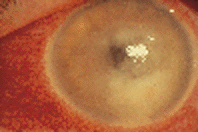Refractive surgery or contacts: help your patients choose
OVERLAND PARK, Kan.—With the growing number of surgical options available, practitioners must present a dizzying array of information to patients who want to discuss their choices for myopia correction. Are you equipped with enough information about the risks of these choices to help a patient decide between contact lenses and refractive procedures?
Most practitioners say advancements have made both contact lenses and surgical modalities safe. Terry F. Hawks, OD, an advisory panel member of Refractive Surgery Services here, said, "Either one of them, if done by the right person under the right circumstances, is relatively safe."
Comparisons of safety and efficacy can be difficult, however. "It's an apples and oranges comparison when you look at the two, and it's difficult to put it in a proper scientific perspective," said Joseph P. Shovlin, OD, part of a co-management group in Scranton, Pa., and also an advisory panel member of Refractive Surgery Services. Perry S. Binder,,MD, president of the National Vision Research Institute, San Diego, agreed, saying, "You've got to compare apples with apples, and refractive surgery is a big term that entails a lot of things."
Complications, loss of visual acuity
 --- Post-photorefractive keratectomy: Haze could reduce best corrected visual acuity even up to a year after the procedure.
--- Post-photorefractive keratectomy: Haze could reduce best corrected visual acuity even up to a year after the procedure.
The issue can be broken down into risk of optical complications or losing best corrected visual acuity (BCVA). Binder pointed out that there are a variety of surgical procedures, and the optical complications and risk of permanent vision loss are different for each.
In comparing loss of BCVA, Shovlin said the risk from daily wear lenses would be expected to be much less than patients who undergo forms of refractive surgery. However, he said, "The risks begin to equal out a bit when you consider the risk-benefit ratio of refractive surgery vs. extended wear lenses. And, relatively speaking, as good as refractive surgery is today, there are enough benefits to greatly outweigh the potential risks of patients losing BCVA."
The risks of loss of BCVA with photorefractive keratectomy (PRK) are "exceedingly small," Binder said. Compared with automated lamellar keratoplasty, he said, contact lenses have fewer side effects. And laser in situ keratomileusis has improved to the point where Binder believes it is safer for the eye and has a lower risk of vision loss compared to contact lenses.
Compared to radial keratotomy (RK), Binder said, extended wear contact lenses have a greater risk of permanent vision loss because of corneal ulcers. "There are more corneal transplants being performed for corneal scars after contact lens ulcers than there are for RK cases," he said. "On that basis, contact lenses definitely carry more risk" than RK.
But an evaluation of optical complications such as light sensitivity, glare, monocular diplopia, undercorrection, overcorrection and irregular astigmatism shows "there's more risk of those things with RK than with contact lenses," Binder said.
Extended wear problems
 --- Acanthamoeba A vision-threatening condition associated with contact lens wear.
--- Acanthamoeba A vision-threatening condition associated with contact lens wear.
Education about the risks of extended wear has increased the safety of contact lenses, as many of the problems with contact lenses stem from wearing them overnight.
Hawks added, "I was never a believer in extended wear anyhow. The major problem is someone sleeping in lenses."
Walter J. Stark, MD, professor of ophthalmology at Johns Hopkins University, Baltimore, simply said, "We advise patients not to use lenses on an extended wear basis."
Which does the patient want?
Safety aside, a patient's refractive error and personal preferences are also factors in guiding the practitioner to the best method of correction.
Stark said practitioners should gauge if a patient is happy with contacts or glasses. "If a patient's doing reasonably well with glasses or contact lenses I would stick with them rather than having a more permanent form of correction, because there are definite risks with that more permanent form of correction."
Many patients may not be ready for the considerable "financial and emotional commitment to refractive surgery," said Shovlin.
Stark said daily wear lenses are not only safe, removable and predictable, but contacts can be shifted to monovision as patients enter the presbyopic age range: "That's not going to be possible with the surgical correction of nearsightedness. People need to have a full understanding of what presbyopia is and how it will affect them."
ODs must be educated
Ultimately, optometrists must be educated enough to present the complete, balanced case to patients. "I think you need to be well versed in all the options to present them in a cogent fashion," Shovlin said. "You need to be able to talk about the apparent risks with the various procedures."
Because optometric education about refractive surgery is still lagging, Hawks said ODs might still not give it "the credibility it probably deserves. Some general education has taken place, but I'm not sure the hands-on education has taken place with a lot of ODs."
This lack of education could imperil an OD's practice in a climate where patients are bombarded with advertising that promotes refractive surgery. Binder said, "If an optometrist says, 'Refractive surgery is terrible, Mrs. Smith. You should never have it," that patient might want surgery and leave that practice."
He said if patients are properly counseled for all the options, "then it's a win-win situation," as they often still will turn to the practice for glasses or sunglasses.
And Shovlin said when presented with the options, many patients opt for contact lenses anyway. "You have to present all the available options," he said. "I always tell my patients this is a decision we'll make together."
